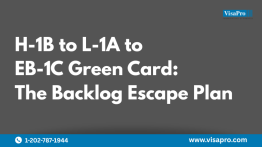Introduction
Companies often need to move their senior personnel around the world. This includes transferring managers and executives to the U.S. to direct their U.S. operations.
Many of these managers and executives contemplate obtaining a Green Card, either to minimize the hassles associated with having to renew their nonimmigrant status or simply because they intend to remain in the U.S. and eventually become U.S. Citizens.
The EB1C Green Card category is the best option for this scenario!
EB1C Green Card – The Advantages
Qualifying for the EB1C immigrant visa category is especially advantageous because ‘labor certification’ is not required.
The labor certification process is tedious and involves several additional steps. During this process, the employer is required to conduct a test of the labor market by recruiting for the offered position to determine if there are any minimally qualified U.S. workers that are ready, able and willing to fill the position. This process adds several months (sometimes years) to the entire process and quite burdensome to the employer.
The EB1C category allows companies to file Green Card for qualifying multinational managers and executives with only a job offer, and without a need for proving that there are no minimally qualified U.S. workers.
EB1C vs. L1A Visa – A Comparison
Foreign nationals coming to the U.S. using the L1A Intracompany Transferee Visa for managers and executives are generally on a direct track to qualifying for the EB1C (Multinational Executives & Managers).
The EB1C closely resembles the L1A nonimmigrant visa in its basic requirements; therefore many people who qualify for an L1A visa may also qualify for the EB1 green card.
For the benefit of employers and multinational managers & executives, here we present a comparison of the L1A and EB1C requirements.
A. L1A And EB1C Requirements – Similarities
Both the EB1C employment-based immigrant visa and the L1A nonimmigrant visa for multinational managers and executives have the following requirements:
- The U.S. petitioner is a parent, subsidiary, or affiliate of a company in another country
- In the three-year period immediately preceding the filing of the petition, or if the beneficiary is already in the U.S., before his or her entry into the United States, the beneficiary must have worked for at least one year overseas with the parent, subsidiary, or affiliated company of the U.S. petitioner.
IMPORTANT
L1A approval does not guarantee an approval of the EB1C for the same beneficiary. Rather an approved L1A simply indicates that the person may have met the initial prima facie evidence of being qualified for an EB1C Green Card.
B. L1A And EB1C Requirements – Differences
The L1A visa allows persons who were specialized knowledge workers in their foreign company to transfer to the U.S. as managers or executives.
The EB1C category requires that the beneficiary’s position at the qualifying foreign company was executive or managerial.
DID YOU KNOW?
Though the L1A visa is perceived to provide an easier path for those interested in filing for permanent residence under the EB1C category, L1A status is not a prerequisite for EB1C eligibility.
C. EB1C For L1B Specialized Knowledge Employees
L1B specialized knowledge employees generally do not qualify for EB1C, unless the petitioner can show that the beneficiary served as an executive or a manager for the company abroad and that a ‘new’ position offered in the United States is ‘executive’ or ‘managerial’.
Let us analyze John’s case below:

My Case Scenario
John
John entered the U.S. as an L1B with specialized engineering knowledge of a bridge building process not in common usage in the U.S. After being here for 2 years the company decided to offer him permanent employment in the U.S. in a managerial position. Would he qualify for EB1C?
Since he was a Project Manager in charge of specific bridge projects in New Zealand before coming to the U.S., and he will be the West Coast manager for all bridge projects the company has undertaken in the U.S., John qualifies for permanent residence under the EB1C category.
D. L1 And EB1C Requirements – The ‘New Office’ Exception
One additional requirement for both the L1 and EB1C is that the petitioning company must be ‘doing business’ as that term is defined by the USCIS, for at least one year abroad and in the U.S. before applying. Under the L1 there is a ‘New Office’ exception to this rule.
Unlike the L1 visa, the EB1C Green Card petition does not have an exception for companies that are launching a new office in the U.S. Instead it requires that the U.S. company has been ‘doing business’ for at least one year before the multinational manager Green Card petition is filed. This limits the New Office L1 beneficiary’s ability to immediately file an EB1C petition. Those beneficiaries who have come to the U.S. to open a new office must generally wait until at least one year has passed (and the first-year extension has been approved).
DID YOU KNOW?
The L1A ‘New Office’ petition enables companies to transfer multinational managers and executives to startup offices in the U.S. if the petitioner can show that the:1. U.S. company has secured sufficient physical premises to house the new office
2. Beneficiary has been employed for one continuous year in the three-year period preceding the filing of the petition in an executive, managerial or specialized knowledge capacity, and
3. The newly formed U.S. company will, within one year, ‘support an executive or managerial position’
The New Office L1A petition will only be approved for one year. At the end of that first year the company will need to file an extension showing that the business is active, fully operational, and requires a manager or executive. This typically involves showing that the company has grown its U.S. revenues and has hired additional employees.
E. L1 And EB1C Requirements – Continuing The Business Abroad
In addition to the requirement that the company be in business in the United States for one year, the petitioner must also show that the company abroad will continue to operate, even after the beneficiary has been transferred to the U.S. office. This is true in both the EB1C and the L1 visa contexts, and is especially true when the transferee is a major force in the success of the overseas company.
The consequences of stopping foreign company operations can be highly detrimental as noted below:
| L1 Nonimmigrant Visa | EB1C Green Card Category |
|---|---|
| Under the L1 visa category, if a company ceases to operate in the foreign country the L1 visa status is invalidated and the beneficiary must change his/her status in the U.S. to another classification, or leave the U.S. immediately. | Under the EB1C category, closing the operations by the foreign company before the beneficiary obtains the Green Card can lead to USCIS denying or revoking the underlying I-140 and denying the permanent residence application. |
For these reasons the continuing operation of both the foreign and U.S. offices is a requirement for L1 and the EB1C categories.
Conclusion
While the EB1C Green Card presents numerous advantages for multinational managers and executives, qualifying for the EB1C visa is not a clear-cut task.
Obtaining prior L1A approval suggests that the beneficiary may likely qualify for an EB1C Green Card since the L-1A and EB1C requirements are very similar, but it is not a guarantee. The petition preparation for this visa category is rather complex, requiring extensive analysis of the underlying facts.
If you are considering securing employment-based Green Card expeditiously, Schedule A Free Immigration Consultation Today >>. Our best immigration lawyers in USA will be happy to assist you.
What VisaPro Customers Are Saying
I am pleased to write a review of my experience with VisaPro, who helped me get my green card. I discovered VisaPro with a web search and arranged an interview with [the Attorney], who quickly ascertained upon reviewing my CV that I wasting my time exploring an O-1 visa but rather I should be looking at the EB-1 category: Alien of Extraordinary Ability. Overall this is a great team who really know what they are doing. One cannot go wrong in using them for your visa needs.

 William Pura, Canada
William Pura, Canada



